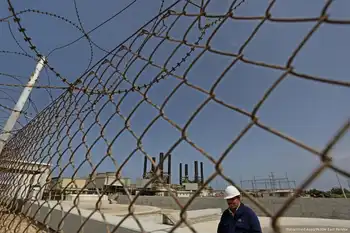Wind turbines vitalize, divide Texas town
By Washington Times
CSA Z463 Electrical Maintenance
Our customized live online or in‑person group training can be delivered to your staff at your location.

- Live Online
- 6 hours Instructor-led
- Group Training Available
In the late 1800s, Sweetwater's founders wondered whether the wind, which blows away topsoil and makes it almost impossible to raise crops, would frustrate their hopes for building a community.
At the turn of the 21st century, town leaders are pinning their hopes on the wind, with expectations it will bring jobs to this area of a little more than 13,000 people and payouts to ranchers who lease their land to national energy companies for their 400-foot-high wind-powered turbines.
Sweetwater Mayor Greg Wortham embodies the hope of civic and business leaders looking to a national surge of support for wind power — through tax dollars, federal guarantees and billions of dollars in private investment — to bring new prosperity to the town.
Local resident Dale Rankin is leading the group of frustrated ranchers who have had little luck keeping the turbines from cropping up around their farms, discovering to their chagrin that the Lone Star State is proving a popular pick for companies looking to build in the renewable energy sector.
Mr. Rankin said he bought the land he lives on 20 years ago as a quiet preserve to raise his family, only to discover the plans for a massive wind-turbine project in his hometown.
"We moved back here to be in an area that was peaceful and quiet, and everything was going well until we started hearing noise about wind turbines," he said. "Then we found out they were planning on building the world's largest wind farm right next to our property. I still believe that no one should have to live next to a wind farm."
The battle of Sweetwater is being played out in towns across the country and around the world. Advocacy groups such as the Industrial Wind Action Group and National Wind Watch have formed to counter what the IWAG describes as "the misleading information promulgated by the wind-energy industry and various environmental groups" about the costs and benefits of wind power.
Among the critics' complaints: The huge turbines, with blades rising as high as 400 feet and continuously blinking strobe lights, are ugly, noisy, a drag on property values, a blight on the landscape, a destroyer of natural habitats and an environmental danger to migrating birds and other wildlife.
Opponents also argue that the industry relies on an artificial market of federal tax subsidies and ultimately works as a redistribution tool giving taxpayer dollars to energy companies and favored property owners. Wind energy, they add, is not as consistent as other "baseload" fuel sources, including coal, which generate power all day, not only when the wind is blowing.
"With these and other adverse impacts, the construction of industrial wind-energy facilities in most places cannot be justified," National Wind Watch argues on its Web site, www.wind-watch.org.
Residents and businesses on Massachusetts' Cape Cod, including liberal Democratic Sen. Edward M. Kennedy, have fiercely opposed a proposed offshore wind farm in Nantucket Sound, in part because the whirling blades of the turbines spoil the seashore view. Another battle is simmering among residents of St. Lucie County in Florida over the construction of turbines.
With Texas the clear leader among states in wind-power-generating capacity, the Sweetwater battle has run along familiar lines.
Both Mr. Wortham and Mr. Rankin left the town decades ago to pursue careers that carried them across the globe. Both men returned home to West Texas in the last decade, but with different agendas.
"You want to find uninhabited areas where people want the development," Mr. Wortham said. "Here people want the power lines, they want wind turbines. We're building houses. We have too many high-paying jobs for too few people."
As the mayor and the executive director of the Texas Wind Energy Clearinghouse, Mr. Wortham has welcomed energy companies ready to invest to build turbines around his small town.
Mr. Wortham said he owns no wind turbines, land with turbines on it or stock in any wind energy companies and that he plowed his retirement money into funding his wind energy nonprofit. He does, however, earn a living as an international wind energy consultant and uses some of that money to bolster his efforts in Sweetwater.
Mr. Wortham left jobs as an energy company executive in New York and a lawyer for the National Rural Electric Cooperative in Washington after noticing that leaders on the East Coast were making a lot of noise about wind energy but that the real wind power was blowing through his old hometown.
"People here weren't reacting to what was here," Mr. Wortham said of the potential for developing wind energy in West Texas. He returned to Sweetwater in 2004.
Sweetwater sits just north of the world's largest wind farm, Horse Hollow Wind Farm, which has 421 turbines and can generate 735 megawatts of power when operating at full capacity.
"We're right in the middle of it. If you look around, you can see wind turbines in every direction," said Bob Warner, a rancher and retired high school principal who moved with his wife to the area four years ago.
The lease payments Mr. Warner gets from NextEra Energy, a sister company to Florida Power and Light (FPL), give him and his wife enough money to raise cattle on land that otherwise would be unprofitable.
"These wind turbines have been a blessing to us. This has supplemented us a tremendous amount," he said. "This is tough country to scratch out a living."
Mr. Warner said he understands why some of his neighbors oppose putting up the turbines, but argued that aesthetics in Texas have not been a particular priority since men began drilling for oil and putting up large metal pumpjacks.
"I can understand that. I don't particularly like oil jacks either, but you learn to live with them," he said.
Johnny Ussery, who owns about 3,000 acres in Nolan County, about 20 miles south of Sweetwater, said he supports bringing on line new forms of energy.
"Our area in West Texas has got to change with the times," Mr. Ussery said.
He signed an agreement in 2005, allowing FPL Energy to put up 28 wind turbines.
"The wind turbines as I see it, as my family sees it, and as most of the people in this community see it, it's progress," Mr. Ussery said. "It's progress not only financially. We look at it as cleaner and healthier for the environment to boot."
Mr. Ussery retired in June 2005 after 30 years working for the Texas utility American Electric Power and within a few months had signed the agreement with NextEra Energy to build the turbines.
Energy companies that come to Texas to tap into the power of wind bring promises of money for ranchers if they open their land to them.
"I think it's fair to say that these wind turbines have made a significant difference from an economic standpoint in many of these landowners' lives," said Steve Stengel, a spokesman for NextEra Energy, which owns the Horse Hollow farm. "It's enabled them to keep the family ranch."
But Mr. Rankin, who returned to Sweetwater with his family after traveling the globe as a businessman, said energy companies are taking advantage of a market created by the government and that consumers will end up taking the hit in higher electricity prices.
"It's like having an oil field suddenly discovered on your place, but it's all federal tax dollars being redistributed," Mr. Rankin said.
But legal efforts to challenge the wind turbines have not borne fruit. Mr. Rankin and 10 other plaintiffs filed a lawsuit to block the construction of wind turbines near their ranches in West Texas, citing noise violations caused by the turning of the windmill blades, but were unsuccessful.
A state appeals courts in a decision in August noted that "Texas case law recognizes few restrictions on the lawful use of property."
The court said, "If the plaintiffs have the right to bring a nuisance action because a neighbor's lawful activity substantially interferes with their view, they have, in effect, the right to zone the surrounding property."
The state's top court recently refused to hear an appeal of the decision.
Mr. Rankin said that even though he shutters the blinds around his house each night to block the blinking red lights on the turbines and chafes at the whoosh of the turbine blades, he understands why his neighbors chose to lease their land to the energy companies.
"I understand where they're coming from," he said. "It's a lot of money they're talking about." He estimated a landowner could fetch upward of $7,000 a year for each turbine he permits on his land, although that number could not be confirmed.
Texas ranchers have had some famous battles over whether to build wind farms, with the anti-wind forces typically on the losing end.
The owners of King Ranch near Corpus Christi, a legendary swath almost the size of Rhode Island, battled their neighbors to the south on the Kennedy Ranch to block the installation of more than 240 wind turbines.
King Ranch was ultimately unsuccessful in its bid to block the wind turbines.
In many ways, the story of Texas wind energy is the story of one of its most notorious figures, former Enron CEO Kenneth Lay, who spent much of the 1990s lobbying for a mandate for the state to boost its use of renewable energy sources such as wind.
A state renewable energy mandate was signed into law by then-Gov. George W. Bush in 1999. Mr. Lay also asked Gov. Bush to lobby Congress to extend a wind-energy tax credit that was first signed into law in 1992 by President George H.W. Bush.
"Ken Lay really jump-started the process which has made Texas the nation's leading wind state," said Rob Bradley, a former economist at Enron who now works for the free-market think tank, the Institute for Energy Research.
EnronWind, which had plans to build wind farms in Texas and California, was ultimately dismantled after the company's spectacular collapse in 2002, with the majority of its holdings being sold to General Electric.
Three years after Mr. Lay passed away — shortly after he was convicted of fraud and conspiracy charges in the firm's fall — the wind-energy lobby has amassed strong pull in Washington, where lawmakers are looking for ways to curb global warming and greenhouse-gas emissions.
President Obama extended the federal tax credit for wind-energy production as part of the economic stimulus plan passed in February. And Democratic lawmakers are hoping to establish a federal mandate that all states buy up to 15 percent of their electricity from renewable sources, including wind farms.
Wind energy made up 0.8 percent of the nation's total electricity use in 2007 and is expected to grow to 2.5 percent of the total, according to the Energy Information Administration. The EIA estimate does not factor in the effects of any global-warming legislation approved by Congress.
What's hard to deny for small-town leaders and residents are the economic benefits from leasing the land necessary for building wind farms.
Sweetwater-based Texas State Technical College-West Texas, a two-year school that grants associates degrees in advanced science, is training students to work on wind turbines.
"Five years ago, our largest program was nursing, but that's been eclipsed in the last few years by our wind technician program," said Michael Reeser, the school's president.
Maria Ortega, one of the 150 students studying for her degree in the program, said she left a job doing payroll and ordering parts for a local company not long after turbines started going up.
"I watched out our window as they developed the turbine from the ground up and just thought it was really interesting," she said, taking a break from her class on electricity principles. "I wanted to be out there in the field instead of here in an office."
Still, it is the ranchers of West Texas who have driven the boom, leasing their land and becoming green energy barons in the process.
"They may not think of themselves as environmentalists," said Mr. Wortham, "but they're definitely environmental stewards."











